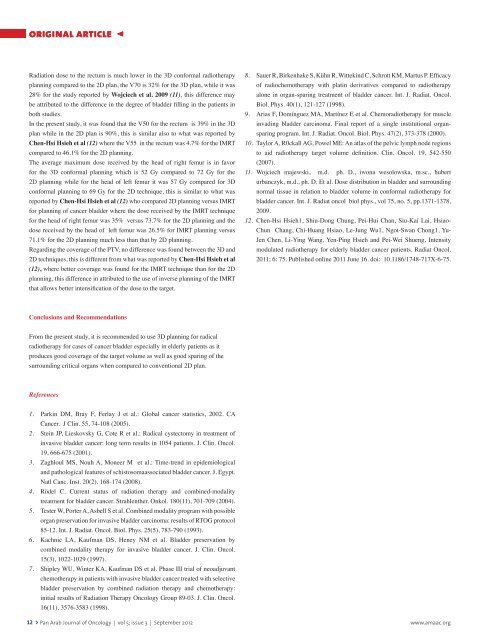Pan Arab Journal of Oncology - Arab Medical Association Against ...
Pan Arab Journal of Oncology - Arab Medical Association Against ...
Pan Arab Journal of Oncology - Arab Medical Association Against ...
You also want an ePaper? Increase the reach of your titles
YUMPU automatically turns print PDFs into web optimized ePapers that Google loves.
original article <<br />
Radiation dose to the rectum is much lower in the 3D conformal radiotherapy<br />
planning compared to the 2D plan, the V70 is 32% for the 3D plan, while it was<br />
28% for the study reported by Wojciech et al. 2009 (11), this difference may<br />
be attributed to the difference in the degree <strong>of</strong> bladder filling in the patients in<br />
both studies.<br />
In the present study, it was found that the V50 for the rectum is 39% in the 3D<br />
plan while in the 2D plan is 90%, this is similar also to what was reported by<br />
Chen-Hsi Hsieh et al (12) where the V55 in the rectum was 4.7% for the IMRT<br />
compared to 46.1% for the 2D planning.<br />
The average maximum dose received by the head <strong>of</strong> right femur is in favor<br />
for the 3D conformal planning which is 52 Gy compared to 72 Gy for the<br />
2D planning while for the head <strong>of</strong> left femur it was 57 Gy compared for 3D<br />
conformal planning to 69 Gy for the 2D technique, this is similar to what was<br />
reported by Chen-Hsi Hsieh et al (12) who compared 2D planning versus IMRT<br />
for planning <strong>of</strong> cancer bladder where the dose received by the IMRT technique<br />
for the head <strong>of</strong> right femur was 35% versus 73.7% for the 2D planning and the<br />
dose received by the head <strong>of</strong> left femur was 26.5% for IMRT planning versus<br />
71.1% for the 2D planning much less than that by 2D planning.<br />
Regarding the coverage <strong>of</strong> the PTV, no difference was found between the 3D and<br />
2D techniques, this is different from what was reported by Chen-Hsi Hsieh et al<br />
(12), where better coverage was found for the IMRT technique than for the 2D<br />
planning, this difference in attributed to the use <strong>of</strong> inverse planning <strong>of</strong> the IMRT<br />
that allows better intensification <strong>of</strong> the dose to the target.<br />
8. Sauer R, Birkenhake S, Kühn R, Wittekind C, Schrott KM, Martus P. Efficacy<br />
<strong>of</strong> radiochemotherapy with platin derivatives compared to radiotherapy<br />
alone in organ-sparing treatment <strong>of</strong> bladder cancer. Int. J. Radiat. Oncol.<br />
Biol. Phys. 40(1), 121-127 (1998).<br />
9. Arias F, Domínguez MA, Martínez E et al. Chemoradiotherapy for muscle<br />
invading bladder carcinoma. Final report <strong>of</strong> a single institutional organsparing<br />
program. Int. J. Radiat. Oncol. Biol. Phys. 47(2), 373-378 (2000).<br />
10. Taylor A, R0ckall AG, Powel ME: An atlas <strong>of</strong> the pelvic lymph node regions<br />
to aid radiotherapy target volume definition. Clin. Oncol. 19, 542-550<br />
(2007).<br />
11. Wojciech majewski, m.d. ph. D., iwona wesolowska, m.sc., hubert<br />
urbanczyk, m.d., ph. D. Et al. Dose distribution in bladder and surrounding<br />
normal tissue in relation to bladder volume in conformal radiotherapy for<br />
bladder cancer. Int. J. Radiat oncol biol phys., vol 75, no. 5, pp.1371-1378,<br />
2009.<br />
12. Chen-Hsi Hsieh1, Shiu-Dong Chung, Pei-Hui Chan, Siu-Kai Lai, Hsiao-<br />
Chun Chang, Chi-Huang Hsiao, Le-Jung Wu1, Ngot-Swan Chong1, Yu-<br />
Jen Chen, Li-Ying Wang, Yen-Ping Hsieh and Pei-Wei Shueng, Intensity<br />
modulated radiotherapy for elderly bladder cancer patients. Radiat Oncol.<br />
2011; 6: 75. Published online 2011 June 16. doi: 10.1186/1748-717X-6-75.<br />
Conclusions and Recommendations<br />
From the present study, it is recommended to use 3D planning for radical<br />
radiotherapy for cases <strong>of</strong> cancer bladder especially in elderly patients as it<br />
produces good coverage <strong>of</strong> the target volume as well as good sparing <strong>of</strong> the<br />
surrounding critical organs when compared to conventional 2D plan.<br />
References<br />
1. Parkin DM, Bray F, Ferlay J et al.: Global cancer statistics, 2002. CA<br />
Cancer. J Clin. 55, 74-108 (2005).<br />
2. Stein JP, Lieskovsky G, Cote R et al.: Radical cystectomy in treatment <strong>of</strong><br />
invasive bladder cancer: long term results in 1054 patients. J. Clin. Oncol.<br />
19, 666-675 (2001).<br />
3. Zaghloul MS, Nouh A, Moneer M et al.: Time-trend in epidemiological<br />
and pathological features <strong>of</strong> schistosomaassociated bladder cancer. J. Egypt.<br />
Natl Canc. Inst. 20(2), 168-174 (2008).<br />
4. Rödel C. Current status <strong>of</strong> radiation therapy and combined-modality<br />
treatment for bladder cancer. Strahlenther. Onkol. 180(11), 701-709 (2004).<br />
5. Tester W, Porter A, Asbell S et al. Combined modality program with possible<br />
organ preservation for invasive bladder carcinoma: results <strong>of</strong> RTOG protocol<br />
85-12. Int. J. Radiat. Oncol. Biol. Phys. 25(5), 783-790 (1993).<br />
6. Kachnic LA, Kaufman DS, Heney NM et al. Bladder preservation by<br />
combined modality therapy for invasive bladder cancer. J. Clin. Oncol.<br />
15(3), 1022-1029 (1997).<br />
7. Shipley WU, Winter KA, Kaufman DS et al. Phase III trial <strong>of</strong> neoadjuvant<br />
chemotherapy in patients with invasive bladder cancer treated with selective<br />
bladder preservation by combined radiation therapy and chemotherapy:<br />
initial results <strong>of</strong> Radiation Therapy <strong>Oncology</strong> Group 89-03. J. Clin. Oncol.<br />
16(11), 3576-3583 (1998).<br />
12 > <strong>Pan</strong> <strong>Arab</strong> <strong>Journal</strong> <strong>of</strong> <strong>Oncology</strong> | vol 5; issue 3 | September 2012<br />
www.amaac.org









